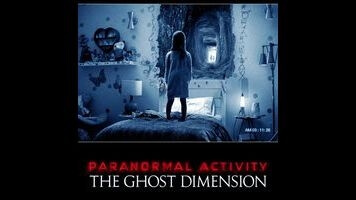By showing the ghosts, The Ghost Dimension kills the Paranormal fun

“For the first time,” the TV spots promise/warn, “you will see the activity.” And sure enough, The Ghost Dimension goes where no Paranormal Activity film has gone before, making visible its invisible menace. But maybe there’s a good reason this hit fright franchise hasn’t thrown back the curtain before now. The 2007 original, with its clever practical effects and simple bump-in-the-dark tactics, scored scares by introducing a monster that could move freely around a house, undetected. Likewise, some of the best moments in the series—see, for the most potent example, the oscillating fan-cam of the second sequel—have deliberately obstructed the viewers’ view, turning the space just beyond the frameline into a great unknown. Sometimes what you can’t see is way more frightening than what you can.
Still, after four rounds of stealthy apparitional mischief in sunny California—five, if you count the generic spinoff The Marked Ones—maybe audiences really do crave a tangible threat, something scary to feast their eyes on. And so evil takes shape in The Ghost Dimension, and that shape is… a floating glob of inky ectoplasm. How underwhelming. In many respects, this supposedly final installment plays exactly like its predecessors, but with all the missing visual information filled in; it’s as though we’re watching the supernatural version of raw green-screen footage, with blobs of demonic goo instead of stunt actors in green bodysuits. More often that not, this neuters the vague unease of the series’ regular tropes: It’s infinitely creepier to see a chandelier mysteriously swaying than to see some amorphous CGI mass clinging to it. And you know what’s less unsettling than a little girl talking to an “imaginary” friend? A little girl talking to a special effect.
The Paranormal movies operate under a fairly rigid formula, with variation coming in the form of different technological wrinkles—the aforementioned fan-cam of part three, the multiple surveillance cameras of part two, the Xbox Kinetic vision of part four. Here, the filmmakers cook up a fictional alternative, a souped-up custom camcorder from the late ’80s, when “video camera” meant something very different than what it means today. Finding the device in an unmarked box tucked away in some dusty corner of his new suburban home, family man Ryan (Chris J. Murray) discovers that by looking through the lens, he can see physical proof of an unnatural presence. The first 3-D entry in the series, The Ghost Dimension uses the stereoscopic element to plunge us through clouds of floating black debris, rippling time-space disruptions, and crackles of ominous static.
It’s a nifty effect, and there’s something disorienting about seeing a third dimension applied to footage that’s meant to look like it’s been recorded on videotape. But first-time director Gregory Plotkin ultimately doesn’t do much with the technology beyond the obvious; it’s just more of the usual stuff-coming-right-at-the-lens. Nor does 3-D make a ton of sense for a found-footage film, at least in terms of narrative logic—though verisimilitude obviously wasn’t a big concern, given that the film outright abandons the illusion of a subjective camera during the prologue, and casts a recognizable actor (Dan Gill, of The Wedding Ringer) as Ryan’s deadbeat jokester brother.
For some reason, the gatekeepers of the Paranormal series have made it a mission to tie all these movies together, as though an overarching mythology were what audiences were paying to see. As Ryan and his brother investigate the origins of their spirit camera and the accompanying collection of creepy tapes, The Ghost Dimension works in malevolent cults, real-estate conspiracies, time travel, the date 6/6/06, and almost as much Poltergeist imagery as the Poltergeist remake. There’s a germ of an interesting idea in the film’s conception of technology as a dangerous conduit between the past and the present; the flat-out best scene here finds our poor, doomed heroes watching footage of themselves watching footage, and noticing one plane of recorded reality interacting with the other. Mostly, however, The Ghost Dimension adopts the same day-by-day escalation strategy as parts one through four, but with an extra element of boneheaded blitheness: If you could literally see the ghosts, would you really wait so long to get a handle on your haunted house?
Under ideal circumstances, the Paranormal Activity films are communal experiences, meant to be watched with a large and even rowdy crowd; if any series deserves those night-vision advertisements of audiences freaking out at advance screenings, this is the one. The Ghost Dimension will surely inspire plenty of theater-wide flinching, a guarantee for any movie with this many jump scares. But by making it so that everyone can see the evil coming, it also robs the franchise of one of its most potent pleasures: studying the frame for signs of trouble, little telltale hints that something is about to go horribly, horribly wrong. Sentient inkblots are a poor substitution for that sensation.